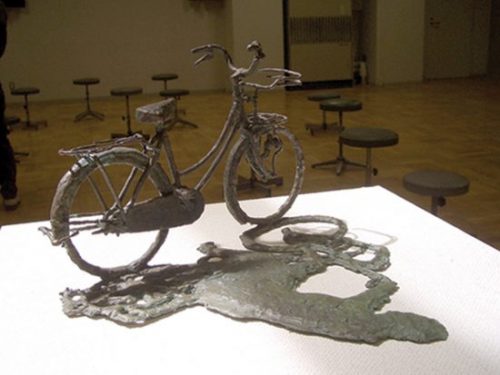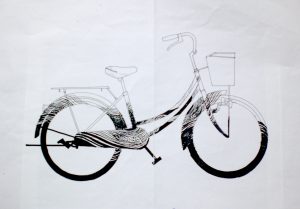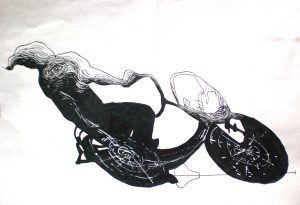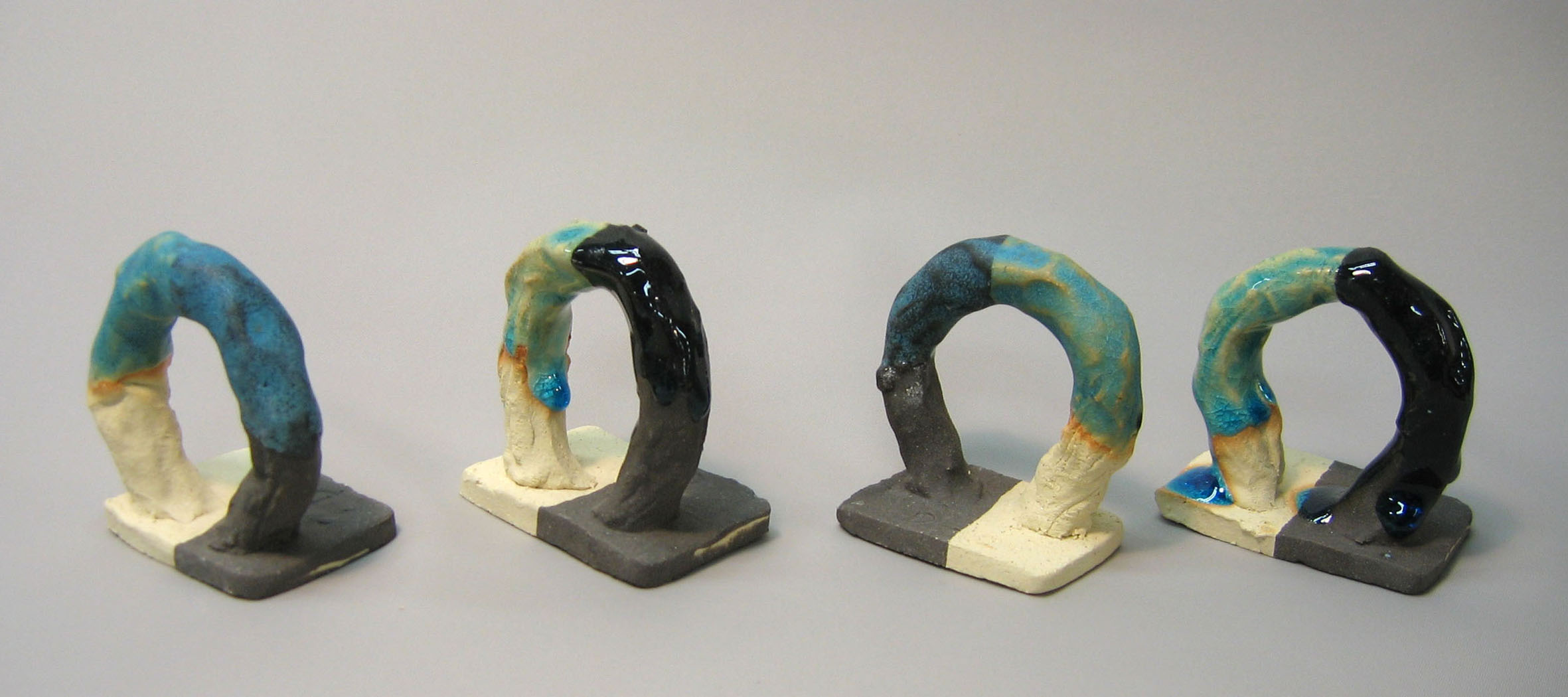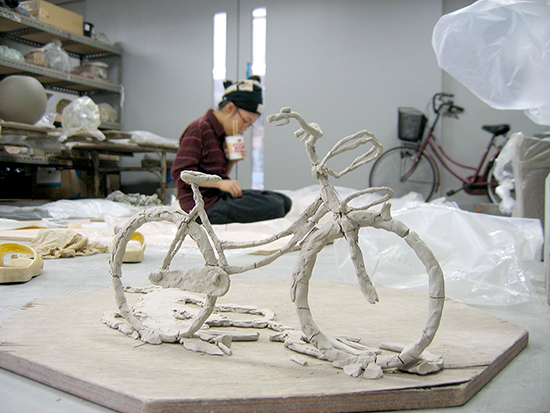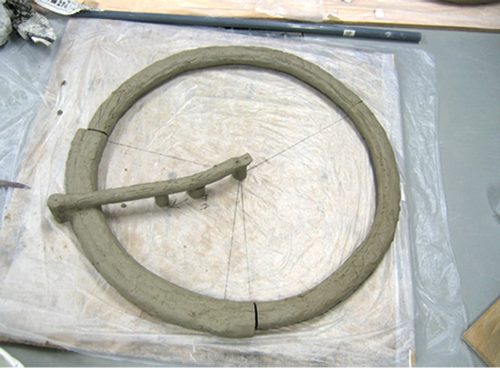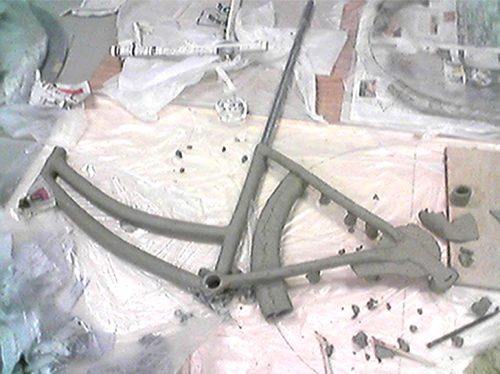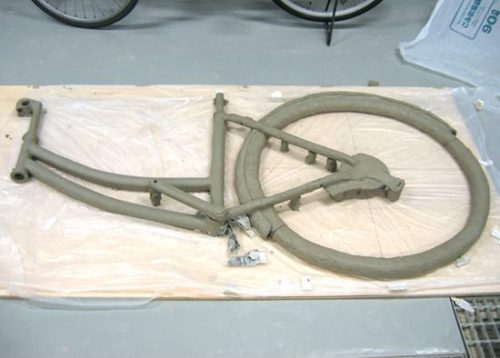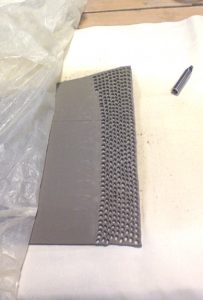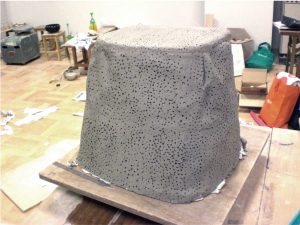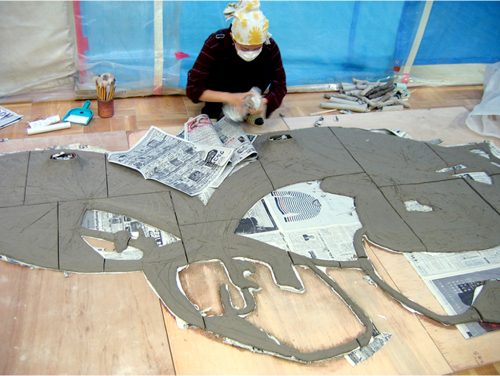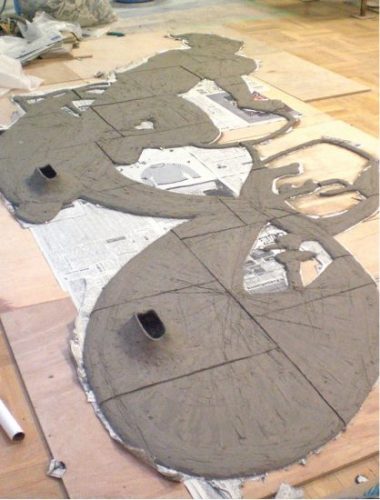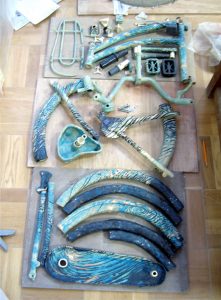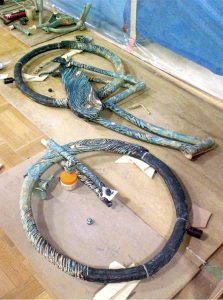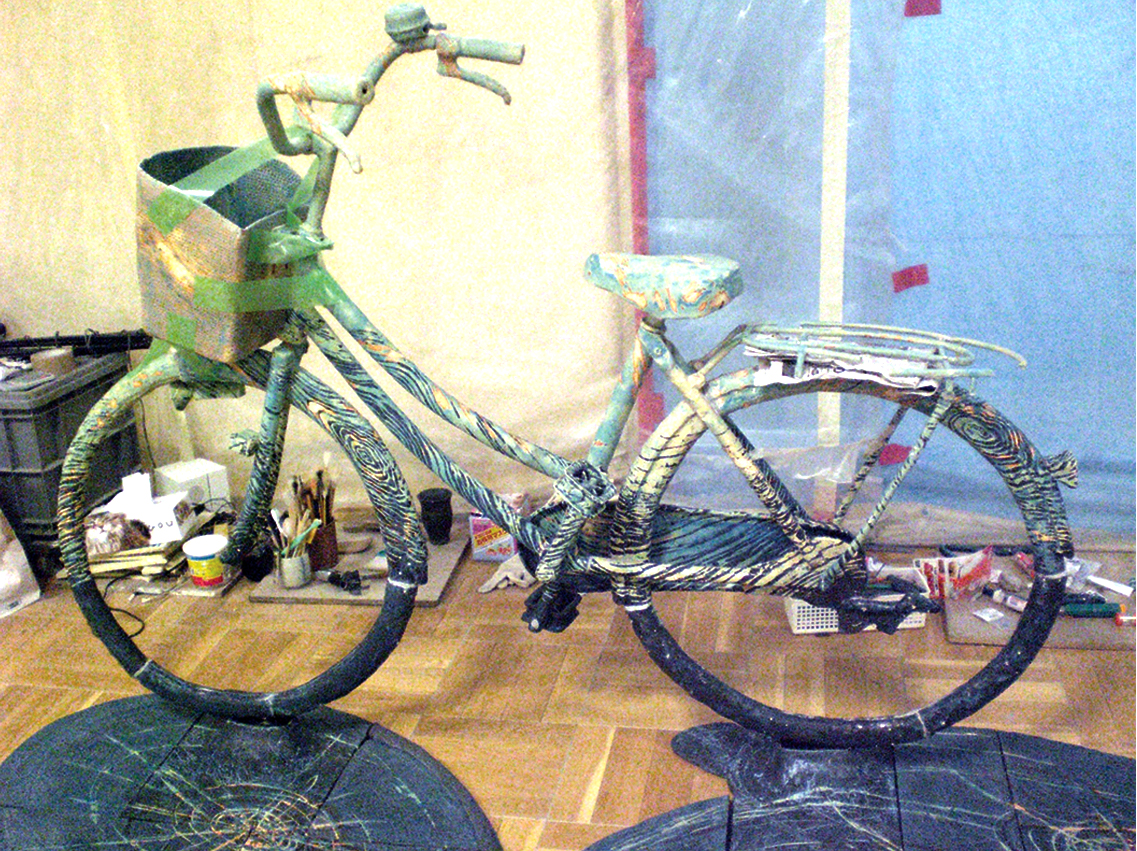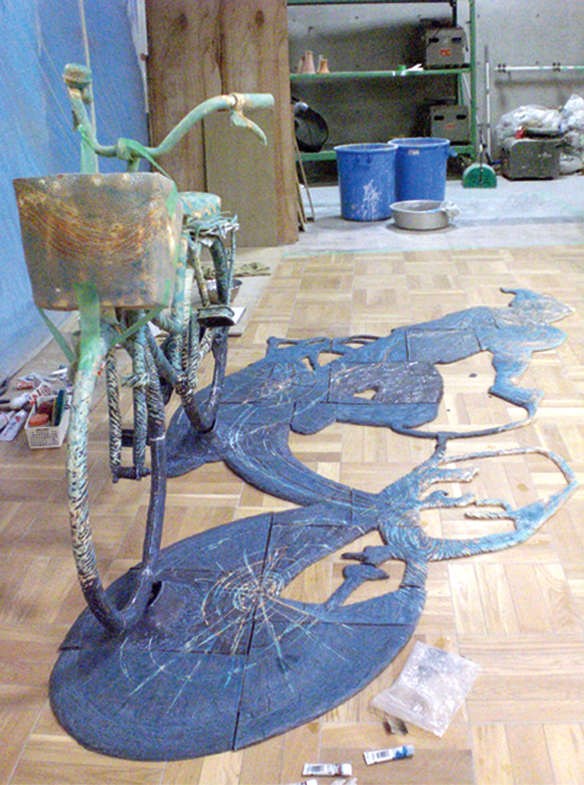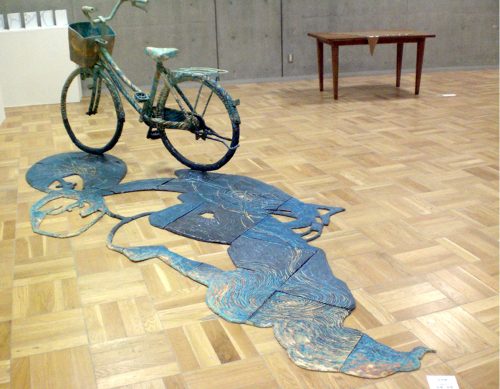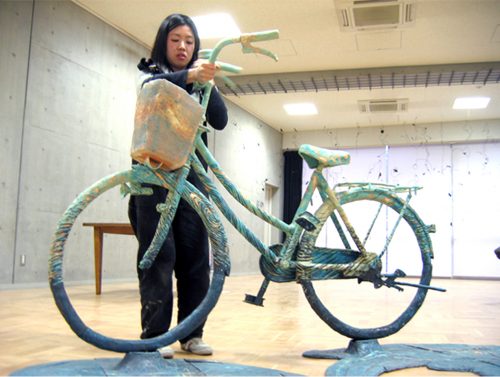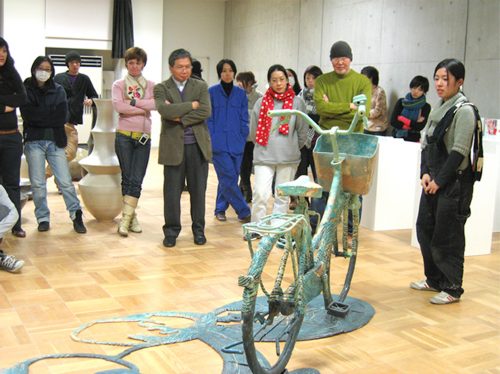Contemporary ceramic artist| BLOG
Introducing my graduation project “For 8 years”
This time I think I would like to introduce my ceramic work called “For 8 years”.
This was the first ceramics piece I made that was not a vessel, and it was my graduation project for TokyoUniversity of the Arts.
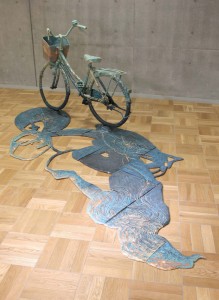
For 8 years
stoneware 1240℃ OF, 2009
W1750×H1100×D3400(mm)
Production concept
“Why have you made a ceramic bicycle…and why is it so big?”
There are many reasons for that.
- As I wrote in my last blog, I thought that I wanted to make a “mysterious and interesting work”.
- I wanted to make a ceramic work that had a concept and was not a vessel.
- For the university entrance examination there was a test to make to make pieces that looked lifelike, so I wanted to use that technique again. As I went to great efforts to learn the technique during my two attempts to enter university, I thought it would be a waste if I did not use it.
- It was the last work I would make at university, so I wanted to try and make something as big as possible.
In a lesson halfway through my third year, I realised that actually I didn’t want to make vessels, so I was wondering what to make.
Eventually I decided to make my beloved bicycle of ceramics.
I used to call that bicycle “Grandpa”, and at that time I had been riding it for 8 years.
That’s why the name of the piece is “For 8 years”.
Stickers from high school and parking lots were stuck to it, and it looked quite cool.
So far it has been stolen from me around four times, but it always manages to be returned to me.
Somehow I feel like it is fate.
In the end I rode it for around 13 years, from the first year of high school until I was 29 years old.
I am not riding it at the moment, but I have kept it safe in storage.
As a side note, I made the same bicycle once before when I was in my second year of university.
That time I made it from a cast rather than with ceramics, and it was titles “For 5 years”.
I wrote this in my graduation portfolio:
“With this work I wanted to express my emotions and memories during the eight years that I rode this bicycle.
I bought this bicycle when I entered high school.
The eight years after starting high school was a particularly fulfilling time, and after looking back on the memories of that time, I made a plan to replace my bicycle with one made from ceramics.
I am riding the bicycle in its shadow, passing between the past and the future.
I wanted to express my feelings about the milestone of graduating university.
I made a piece called “For 5 years” before making “For 8 years”, which were both modelled on the same bicycle.”Excerpt from my portfolio.
Graduation project meeting
During the process of making my graduation project, I met with professors and lecturers once a month, but they said the bicycle was “not good” at the first meeting.
They told me that “you cannot make bicycles out of ceramics”.
My seniors told me “choose things with your own abilities in mind”, it was a bad reaction…
However, by nature I stick to one thing and have a very persistent personality, so I tried discussing it with my father who is a ceramic artist.
So, after my father thought for a little while, he replied
“You can do it can’t you?”
This gave me confidence and I thought I might be able to do it somehow.
Then I starting preparing to try and convince the faculty members.
I made rough sketches and design ideas like the ones below to try and persuade my teachers.
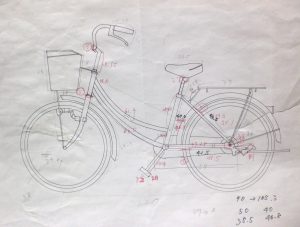
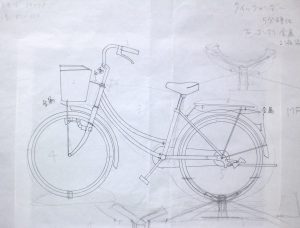
The result of the strategy was successful.
They said “why don’t you try it”.
I wrote this in my graduation portfolio:
“In order to make a bicycle from ceramics it was necessary to make its complicated form accurately.
The planning stage was very important, and I had to produce several preliminary drawings.
Since clay shrinks during drying and firing, I measured the shrinkage rate of the clay to calculate the precise size to mould.”Excerpt from my portfolio.
I had to keep the clay shrinkage in mind when deciding the division and dimensions of each part.
The parts in this work are made to fit together, so I had to be careful to not distort any piece during production as they would no longer match.
Starting the production of my graduation project
It was a little early but I started production in June.
Because it was a big piece, it helped me to relax a little by starting earlier.
The first thing I did was a glaze test. I made a glaze colour to match my bicycle.
Around this time I married my husband who is from the Middle East (Iran). I was interested in using light blue glaze over black slip that has been scraped off, something that is used in famous ceramics in the Middle East.
Light blue is commonly called “Turkish blue”.
It seems like Iranian people call it “Persian blue”.
People who have studied ceramics probably know this, but this kind of light blue uses copper as a colouring agent. Copper reacts with oxygen during oxidation firing, and when it is completely oxidised will turn a light blue colour. The truth is, most of the glazes I make are coloured with copper.
This is because my favourite colour has been light blue since I was born.
So, light blue was the only choice.
The wheel-like structures in the photo above are test pieces.
I made about 50 different types of test pieces in total, and I used the matte light blue glaze that I liked the most out of them.
The black sections are coated with black slip.
Black slip is a technique where the base of white clay is covered with a coating of black clay.
The “scraped off black slip” that I mentioned above refers to a technique where a pattern is applied by scratching off black slip to reveal the white base.
My work was very big which made it impossible to make a pattern by the “scraping off black slip” technique, so I decided to make the design using black slip and the colour of the white base.
I wrote this in my graduation portfolio:
“The reason I used a light blue glaze was that I was interested in Persian ceramics at that time and also light blue was my favourite colour. I applied a design using black slip on white clay, but this was also an influence from Persian ceramics. After taking the size of the work into consideration I decided to use coarse clay as my medium.”
Excerpt from my portfolio.
“After taking the size of the work into consideration I decided to use coarse clay as my medium.”
This explanation is insufficient so I will expand on it here.
When a ceramic work is big, it is prone to cracking after drying or firing.
This is because the clay is too heavy and friction along the base prevents the work from shrinking evenly.
This is particularly a problem with fine clay, as there are fewer gaps between the clay particles, and so there is not much flexibility when it shrinks. As a result it cracks.
Therefore to try and reduce the chance of this happening, I used coarse clay.
Starting to make the body of my work
The photo above shows a model that I made.
I was always conscious of the entire shape as it the work was so big.
If I did not pay attention to the entire form and made a mistake later on, I would not have had time to correct it. It is the same as when you are drawing.
In the background you can see me eating cup noodles from 10 years ago.
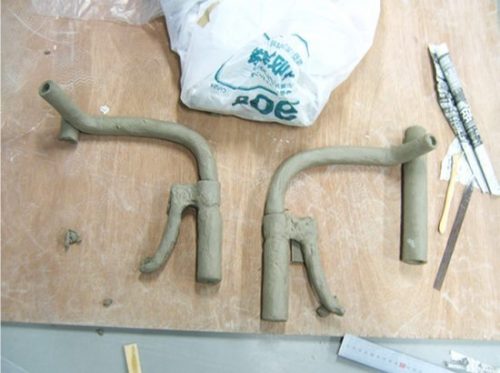
Now it is time to make the bicycle. First, the tyres and handlebars.
As you can see in the photo, the tyre is divided into sections.
To make sure the bicycle can stand up, some craftsmanship was required for the inside of the tyre. The bottom section of the tyre was made as a base and a lid.
The left and right handlebars were matched up after firing.
Next was making the frame. In the photograph on the left there is only one tyre.
The reason for this was that I could not fire everything together as it was too big for the kiln. After thinking about how to assemble all the parts, the only option was to divide the bike in this way.
It is really similar to making a plastic model or a three-dimensional puzzle.
The photograph on the right shows the tyre arranged with all the other parts.
The photograph above shows the process of making the basket. I thought that if I made lots of holes in a thin layer of clay it would be similar to the appearance of a basket.
To make the shape of the basket, I made a mould out of newspaper and covered it in the clay.
If you use a hard material for the mould, the clay will crack as it shrinks.
The newspaper inside can be removed after the clay has hardened slightly.
These are the parts for the shadow of the bicycle.
First I made a shadow with all the parts connected.
There are two hollow parts for the base of the bicycle to attach to.
I then divided it immediately before it dried.
If you let it dry as it is, the drying is too sudden and the clay will crack and distort. I covered it with a big sheet of plastic and let it dry while the newspaper absorbed the moisture.
I put a lot of newspaper on the shadow pieces and replaced it every day with dry newspaper.
It was my first time making such a big ceramic work, so naturally some of the parts broke.
The next stage was:
Bisque firing (750ºC )
As it can crack easily up to 300ºC, it was fired with a slow increase in temperature.
↓
Slip coating
I applied a pattern using black slip.
I applied a water repellent to the areas that I did not want to cover with slip.
By doing this I could make a pattern from the parts that were and were not covered with slip.
↓
Glazing
The work was too big to dip it in glaze, so I used a ladle.
↓
Firing (1220ºC)
If the temperature is raised too high the glaze will become transparent, so I kept the temperature low.
As it was 10 years ago I cannot find many photographs.
The photograph on the left shows the pieces after firing.
All the parts are separate, and I fixed them together afterwards.
The photograph on the right was taken part way through the bonding process.
“During the bonding process, I put sections of iron inside the lower part of the tyre and inside the shadows.
This meant that when they were put together, the bicycle could stand up by itself.”
Excerpt from my portfolio.
The black things you can see sticking out of the bottom of the tyre are the metal parts needed for the bicycle to stand up by itself.
I made it so you cannot see the metal parts joining the shadow and the bicycle, but inside each there are metal joint parts for self-support.
After the pieces were fired, I asked my friend who was majoring in forging to make them for me!
As they were made very sturdily, the bicycle body is unlikely to wobble.
Unfortunately I could not find any photographs of the metal parts.
The photograph above was taken during the final stages of assembly, when I was attaching the basket.
I glued the parts together in sections so that they could be separated easily for moving or storage.
“The bicycle can be separated into parts. In total it is divided into 70 parts, with each part small enough to be carried by hand.”
Excerpt from my portfolio.
Yes that’s right. There were a lot of parts.
Finally it was completed!
It took 7 months to be completed, but when it was finally done I felt a big sense of accomplishment.
Even now, I haven’t made another ceramic work of this size.
Sometime in the near future, I would like to try and make a ceramic bicycle again.
This is a seminar for the ceramics majors which took place just before the graduation project exhibition.
After the work was completed, I summarised it like this.
“Since I worked a lot on planning, I could complete the actual work in quite a short period of time.
I will be able to use the techniques that I learned in future works, such as making pieces from clay slabs, and dividing a piece into sections.
However I regret concentrating too much on the construction, and not reconsidering the composition of the work.
For example, I think I could have represented the shadow in a more abstract way, and omitted the actual shadow completely.
This work is a little abstract and a little concrete, and cannot be defined as either.
In order to make something real with clay, we must deform its shape and make something that fits the subject matter.
However, you must also not go too far from the motifs you have made.
If the work is too far from the motif then it will not evoke any human emotions or memories in the viewer.
If these are not evoked, then my concept of “emotions and memories remain” cannot be expressed.
For my next work I would like to try and choose the best method for expressing my production concept.”Excerpt from my portfolio
So, after this work, after worrying a little about the direction of my work, I started to make my contemporary ceramic works titled “Shower” and “Tap and bucket”.
Attitude when working on things
When I am working on something, there are things I have sworn to do since preparing for my entrance examinations.
It is to maintain an “attitude of attack”.
This way of thinking has always been a support for my mind, and was taught to me by Mr Sekii during my time at prep school.
When I am wondering “what should I do?” or times when I am hesitating, I shake off that feeling and try and continue towards the best possible route.
Occasionally I take it too far and go beyond the limits of my own body, but I try and do my best to remain within those limits.
My husband told me, “It is better to fail trying than to not try at all”. I like these words are they are pretty compelling.
My husband was an international student from the Middle East, so people often think he is from a rich family. However the truth is he is the son of a rural farmer. With 8 siblings.
In his home there is no electricity or bath. Apparently he had never seen a car until middle school.
Every day during his childhood he would surround one lamp with his siblings, and study until falling asleep.
He is a person who has never slept on a futon, and puts in so much effort you could attach the prefix “hyper”.
Luckily, education seems to be free in Iran, so putting in a lot of effort can put you on the right track.
Thanks to that, against all odds, he managed to come and study in Japan.
Do not fear failure, try first.
As a result there are lots of ways you haven’t failed, you will soon arrive at the path of success, and live a life like that described in the words above.
If you don’t try, then you will extinguish any possibility of success.
Even if you fail your life is not over.
So, it is ok to fail!
If you fail, you just have to think about what to do next.
After hearing this, everything seemed very easy, and I felt like I wanted to try everything.
Japanese people think that failure is bad, but I have my doubts about that way of thinking.
It may be better to hold the stance of the words above.
First I will try, then I will try to continue, and in this way I want to tackle various things in life.
Thank you for reading this long blog post until the end.
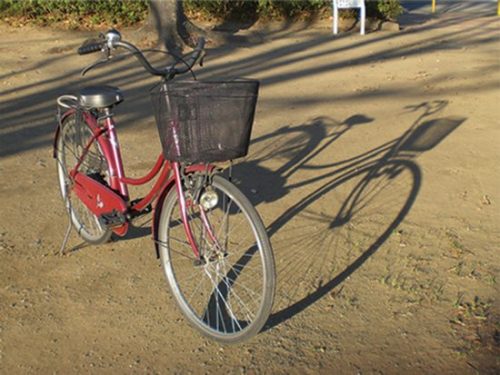 f
f